|
Posted on 11/09/2003 12:00:33 AM PST by SAMWolf
|
|
 are acknowledged, affirmed and commemorated.
|

| Our Mission: The FReeper Foxhole is dedicated to Veterans of our Nation's military forces and to others who are affected in their relationships with Veterans. In the FReeper Foxhole, Veterans or their family members should feel free to address their specific circumstances or whatever issues concern them in an atmosphere of peace, understanding, brotherhood and support. The FReeper Foxhole hopes to share with it's readers an open forum where we can learn about and discuss military history, military news and other topics of concern or interest to our readers be they Veteran's, Current Duty or anyone interested in what we have to offer. If the Foxhole makes someone appreciate, even a little, what others have sacrificed for us, then it has accomplished one of it's missions. We hope the Foxhole in some small way helps us to remember and honor those who came before us.
|
|
Although small and relatively unknown, Fort Brown in Brownsville, Texas was nonetheless important in the changing tides of history of two neighboring nations, the United States and Mexico. Juan Nepomuceno Cortina, photographed while governor of Tamaulipas, Mexico, led a bandit gang that sacked and burned United States border towns.  Brownsville, Texas, beside the Rio Grande River, is a short walk over the water from Matamoros, Mexico. United States President James K. Polk, who envisioned a nation stretching to the Pacific Ocean, had been elected the year before. Much of the territory he sought belonged to Mexico, which then encompassed New Mexico, Arizona, and California. Polk hinted that if Mexico wouldn't sell these territories, the United States would seize them. He also championed Texas's claim to a southern border along the Rio Grande. Issues of western expansion and the disputed Texas border became intertwined. "Manifest Destiny" was a popular slogan of the day, reflecting a view that the United States was destined to control vast territories. Bolstered by such sentiments, Polk sent an emissary to Mexico to buy western lands. When Mexican officials rejected the offer, Polk ordered U.S. troops, led by General Zachary Taylor, to invade the disputed region between Texas and Mexico. The president was knowingly courting war. If bloodshed erupted, however, he wanted Mexico to be perceived as the aggressor. Having United States forces in the disputed region increased the likelihood that Mexican troops would cross the Rio Grande and strike the first blows. Powerful voices in the United States spoke against Polk's provocations, including John Quincy Adams, a former president; John C. Calhoun, a former vice president; and philosopher Henry David Thoreau.  In March 1846, Taylor's army of 3,000 crossed the Nueces River and marched south, passing through today's sprawling King Ranch. At the Rio Grande, the general ordered a halt on a peninsular bluff beside a bend in the river, directly across from Matamoros. Seeing the U.S. soldiers, many of the 20,000 residents fled south, leaving behind a population of about 4,000 and the Mexican army. United States troops paraded into their new camp with much pomp and ceremony. Drums beat, colorful flags and banners waved, and a band played martial music while Mexicans on the other side of the river quietly watched. The spectators must have been uneasy, wondering what would happen with so many foreign troops stationed a stone's throw away. Also watching were members of the Mexican army, about 5,000 strong, commanded by General Francisco Mejía.  General Zachary Taylor Mejía quickly sent a message to Taylor, protesting the presence of U.S. troops on Mexican soil. Taylor responded that his army had every right to be there because they were on United States property. In the ensuing weeks, other increasingly insistent notes were sent demanding that Taylor and his men leave. All met the same response. Taylor's soldiers spent this time building Fort Texas. (Only later, after blood spilled, was the post renamed Fort Brown.) Guided by chief engineer Captain Joseph K.F. Mansfield, they followed a plan calling for an earthen structure with walls 15 feet wide shaped into a six-sided star. Laboriously, the men molded and stamped the dirt. The finished walls would stand nine to 10 feet tall. They dug from ground surrounding the emerging fort walls, purposely hollowing out a ditch about eight feet deep and 15 to 22 feet wide, creating another defense around the fort perimeter. A draw bridge would span the ditch, and a gate would be placed at the only entrance. When completed, the fort would project out to form palisades at each of the star's six points where soldiers placed cannons with barrels facing every possible approach, including Mexican gun emplacements on the opposite side of the Rio Grande. Sandbags stacked around the weapons gave added protection against incoming shells.  Plans for Fort Brown From atop the fort walls, soldiers could see across the river into Matamoros. The tall spires of the stately Catholic cathedral, still in existence today facing the Plaza Hidalgo, were clearly visible. At least some of the city's inhabitants were undeterred from daily routines by the troops' close presence. Women continued to bring laundry to wash in the river on the Matamoros side, almost within the shadows of Fort Brown's menacing guns. Nor were the Mexican forces idle while Fort Texas took shape. They strengthened Matamoros's defenses, its forts and gun emplacements. One of the forts of the era, the Casamata, still stands and is maintained as a museum of Mexican history. War fever filled the air. Everyone expected shots to be fired, but nobody knew when or where. Rumors swirled that the Mexican army was crossing the Rio Grande, justified rumors because the new Mexican commander, General Mariano Arista, was considering just that. He feared that Matamoros could not withstand a siege if, as he expected, U.S. troops attacked. Arista decided to take the initiative.  General Mariano Arista Meanwhile, Zachary Taylor dispatched a patrol of 63 mounted troops, called dragoons, to survey up river to learn whether the Mexican army was indeed crossing to threaten Fort Texas. On April 25, 1846, the dragoons, led by Captain Seth Thornton, rode through an opening into a field surrounded by thick brush at Ranchos Carricitos. The soldiers were headed toward buildings in the field when some 2,000 Mexican cavalrymen commanded by General Anastasio Torrejon appeared and sealed off the only exit. Shots were fired as the U.S. soldiers mounted a disjointed and futile charge, then galloped frantically in all directions, seeking escape. The fight ended quickly. Eleven U.S. soldiers died, and most of the remaining force was captured, including Joseph Hardee who later became a Confederate general. But at least one dragoon escaped and slipped back to Fort Texas with word of the military disaster. Now the president had provocation to seek a declaration of war, which the United States Congress soon supplied. The push to complete Fort Texas intensified.
|

For a while in 1860, Lee stayed at Ringgold Barracks at present day Rio Grande City. Ringgold Barracks was named after Major Ringgold, mentioned in your history of the Mexican War in the Valley.
My great-great-grandfather was stationed at Ringgold Barracks in 1864-65 while in the Confederate Army under Colonel RIP Ford. My ancestor's unit fought Cortina in 1864, as well as Federal troops on the coast.
RIP Ford was something else. While leading a Ranger Company in 1859 and again in the Civil War, he went across the Rio Grande in pursuit of Mexican invaders and defeated them on their own soil.
Too bad we don't have men who are willing to do that today.
Thanks for the links and background on the "Cortina War". I seem to recall some border problems in the early 1900's with Pancho Villa.
I guess every once in a while we need to show Mexico that we do have a border.
We just needed to show them there was a better form of government and we were going to have it. Once we convinced them to move along, we remained civil.
It's all in the culture of the people you are fighting,imo. ;)
Glad you enjoyed the movie and got to witness our fighting spirit.
 <=== Mash This
<=== Mash ThisThey were not, and became recent political pawns.
I worked for the re-election of Congressman Bill Redmond elected to fill Bill Richardson's seat in 1997 who ran on a promise to honor the grants.
Direct descendants had been petitioning members of the government and Redmond--a conservative Republican anglo minister from Chicago--was the first to put the matter before the House.
Udall of the ecowhacko Udalls defeated Redmond and the matter died.
Of note is this: one of the most outspoken of the direct descendants reported that the major obstruction lies with a prominent family of Democrat attorneys who own some of these grants.
And the outspoken descendant? Another active lifelong Democrat.
The victim and the villain uniting to defeat the would-be rectifier of historic wrong.
As the city councils of Santa Fe and Albuquerque resolve not to cooperate with the INS and all my neighbors hablan Espanol solamente.

The Colt Whitneyville-Walker Pistol
Lt. Col. Robert D. Whittington, III
A study of the genesis of the first great Colt gun. Traces the lively collaboration between the inventor and Captain Samuel Walker, the gun's heroic champion.

The Colt Whitneyville-Walker Pistol, AKA: the U.S. Model 1847
Date: 1847
From The Colt Whitneyville-Walker Pistol by Lt. Col. Robert D. Whittington, Ill., Taylor Publishing Company, Dallas, Tex., 1984
“The Colt Whitneyville-Walker Pistol, also known as the U.S. Model 1847, was the first repeating pistol purchased by the Army Ordnance Department for service use. . . the term ‘pistol’ is used in the text primarily because the term ‘revolver’ was not in general use during the period.”
The Ordance Department contracted for 1,000 of the pistols, which were serial numbered by the company.

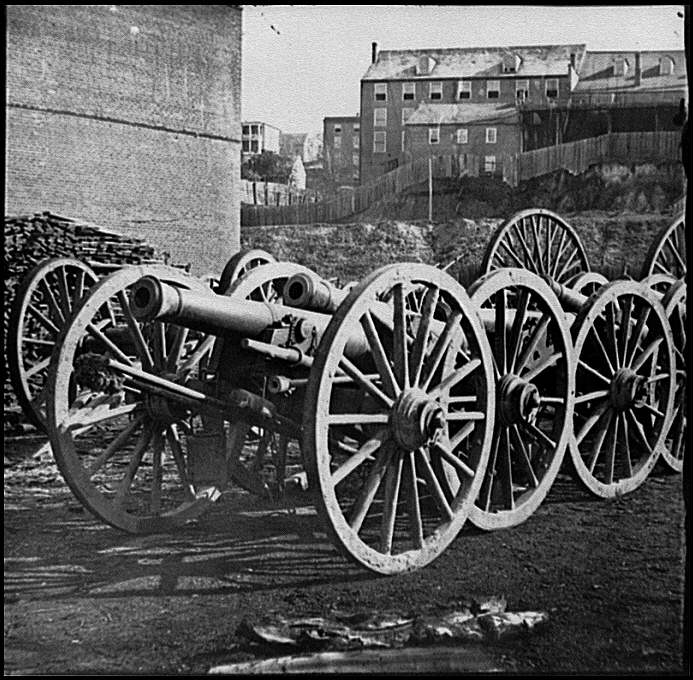
Model 1841 6-pounder field guns
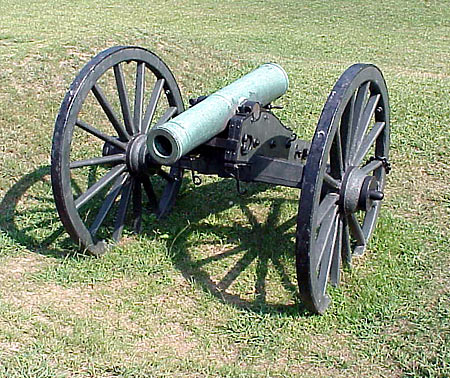
The Model 1841 12-pounder was the standard field howitzer used in the Civil War. Because of its higher trajectory at which it was typically fired, it could fire a shell over 1,000 yards with less than one pound of powder.
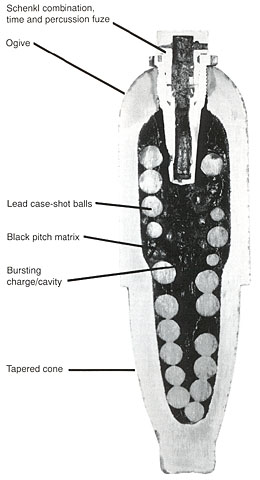
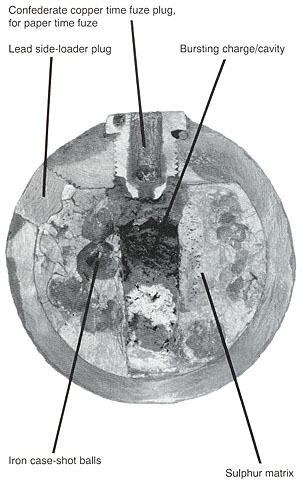

Canister Shot - These are CSA canister shot. They were all dug together at Knoxville, TN. These are a little rusty due to their composition but in otherwise perfect condition. They measure about 1" in diameter. VERY NICE!!!!

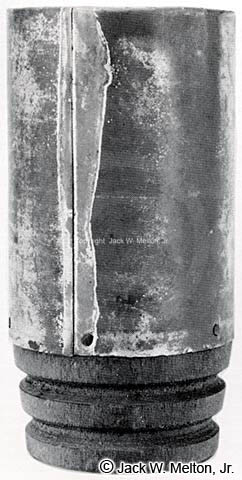
Federal
Conical
DIAMETER: 3.59 inches
GUN: 6-pounder smoothbore, 3.67-inch caliber
LENGTH: 6 7/8 inches
WEIGHT: 7 pounds 8 ounces
CONSTRUCTION: Canister
SABOT: Wooden cylinder
FUZING: None
This specimen is non-excavated and is an example of the most common style canister used in the 6-pounder (3.67-inch caliber) smoothbore cannon. It is 3" shorter than the standard style 20-pounder canister, also for a 3.67-inch bore. Both Northern and Southern forces used this size canister. After attachment of the cartridge bag, which was tied to the deep grooves cut into the wooden sabot, the round was referred to as fixed ammunition. Note the vertical solder seam running the length of the tin cylinder.
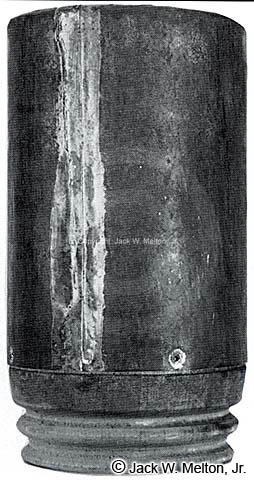
Federal
Conical
DIAMETER: 4.50 inches
GUN: 12-pounder smoothbore, 4.62-inch caliber
LENGTH: 8 inches
WEIGHT: 14 pounds 11 ounces
CONSTRUCTION: Canister
SABOT: Wooden cylinder
FUZING: None
This non-excavated specimen is the standard-style canister that both the Federal and Confederate forces used in the 12-pounder (4.62-inch caliber) smoothbore cannon. Canister was designed to be fired at close range with a resulting devastating effect on the enemy. A 12-pounder field gun with a powder charge of 2.0 pounds, fired a 12-pounder canister with an initial muzzle velocity of 1,262 feet per second.
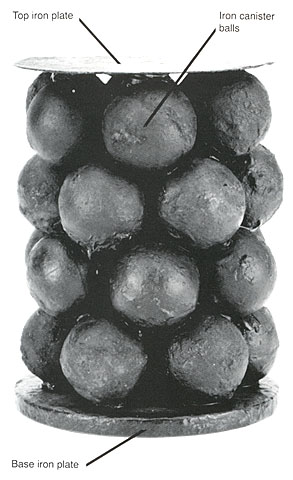
Federal & Confederate
Conical Canister
This specimen was reconstructed to illustrate the interior view of a standard 12-pounder (4.62-inch caliber) canister. Sawdust filled the spaces between the iron balls found in the pictured specimen. The tin sides are missing, as is the wooden sabot. Note that the top plate is thinner than the bottom plate, which had to absorb the initial discharge force during firing. This pattern of construction is typical of both Federal and Confederate canisters.
Espero que usted sólo hable con ellos en inglés!
English first! I hate that my tax dollars go to translate OUR AMERICAN language into any other language to be voiced or printed to the masses that refuse to learn. /rant
Disclaimer: Opinions posted on Free Republic are those of the individual posters and do not necessarily represent the opinion of Free Republic or its management. All materials posted herein are protected by copyright law and the exemption for fair use of copyrighted works.